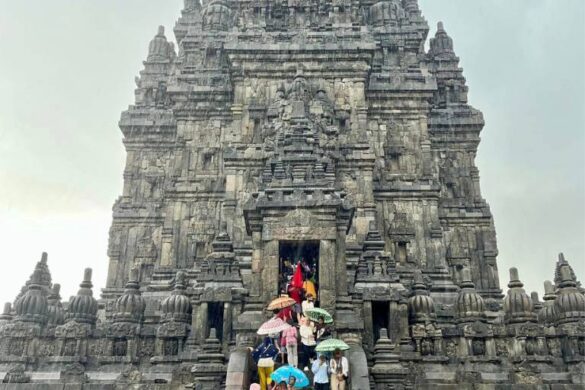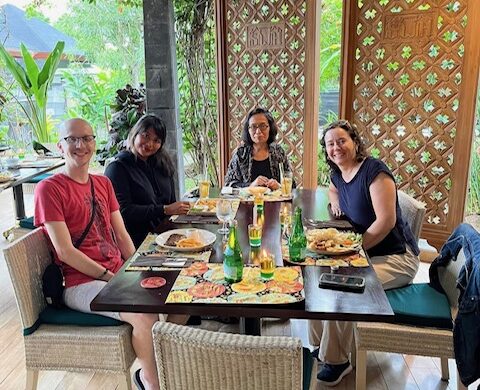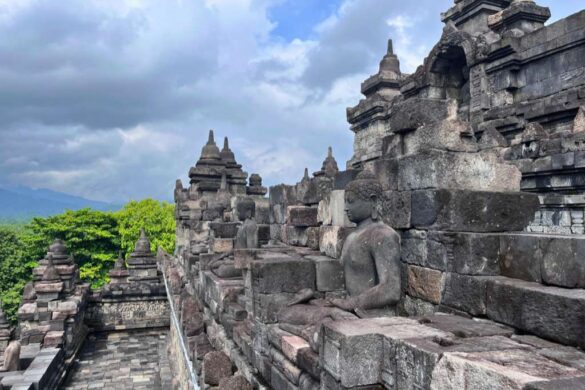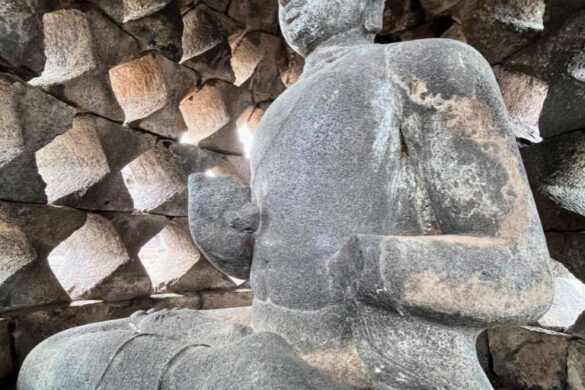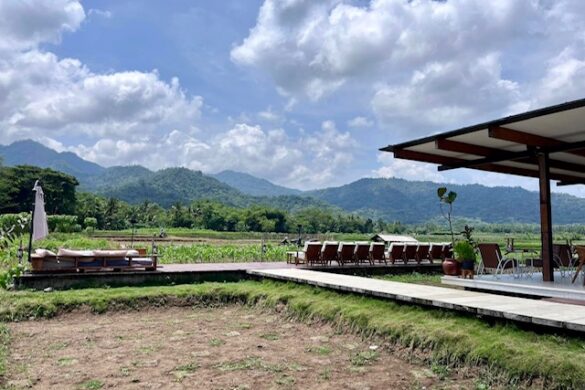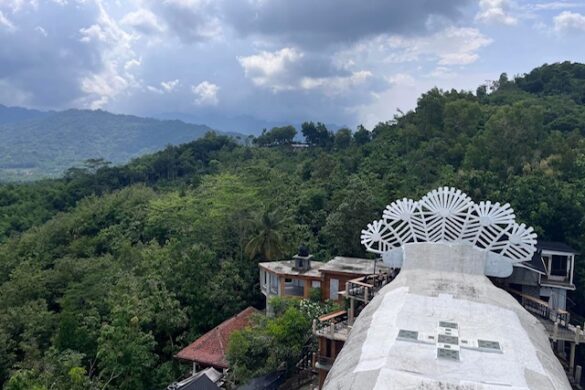This post contains affiliate links. If you make a purchase through these links, I can earn a commission at no extra cost to you. Thank you!
While visiting my son and his fiancé in Jakarta, we decided to go spend two days in Yogyakarta. None of us had been there before and we were looking forward to seeing another part of Java.
We took the train from Jakarta, stayed two nights in Yogyakarta, and then flew back to Jakarta. It was a quick visit, but I think we made the most of our short time.
Our main goal was to visit Borobudur and Prambanan Temples so that’s what our two day itinerary is centered around. We also hired a private driver for each of the two days that we were there.
In this post, I’ll share what we saw during our two days in Yogyakarta, where we ate lunch, and where we stayed in Yogyakarta, as well as costs and some additional suggestions if you have more time.
Taking the Train from Jakarta to Yogyakarta

We took an early morning train from Gambir Station in Jakarta.
This was my first time on a train in Indonesia and I have to say it was lovely! It was clean, comfortable, and we had plenty of room to stretch out. There’s a dining car where you can get some snacks or a light meal too.
The best part about taking the train though is that it goes through the countryside. You’ll pass by rice fields, small villages, and you may even see the local children waving as you go by.
The worst part about taking the train to Yogyakarta is that it isn’t quick. It took about 7 hours. By the time we arrived in Yogyakarta, it was already early afternoon. Our two days were more like one and a half days.
Just something to keep in mind as you plan your schedule.

Two Days in Yogyakarta
When visiting Yogyakarta for the first time, the two things that top everyone’s list are seeing Borobudur and Prambanan Temples. They were certainly at the top of our list! The problem is that each temple is an hour drive from Yogyakarta…and in opposite directions.
Should you visit both temples on the same day? Or should you go to one each day? Going to both temples on the same day is certainly doable, it just makes for a very long day.
To make sure we didn’t feel rushed, we decided to visit one temple each day.
This is how we spent our two days in Yogyakarta visiting Prambanan Temple and Borobudur Temple on separate days.
Day 1: Prambanan Temple, Lunch, and Malioboro Street
Prambanan Temple
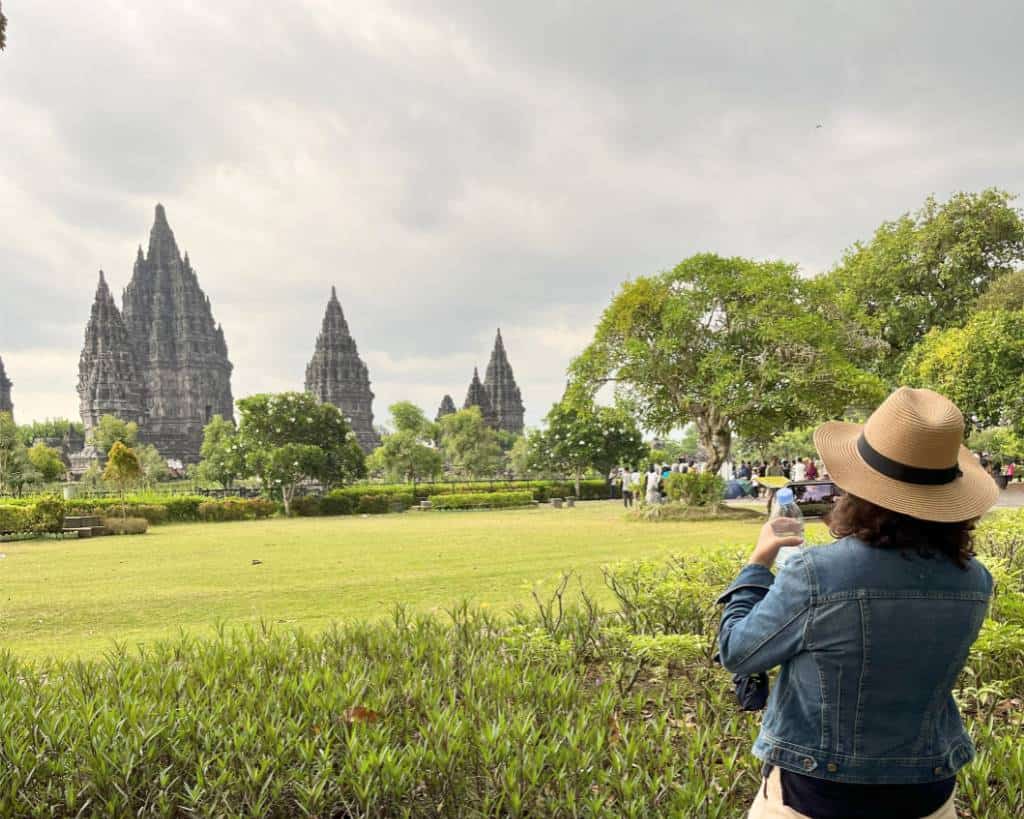
After checking into our hotel, and having eaten a light lunch on the train, we decided to head on over to Prambanan Temple. We thought about going to lunch first but it was already after 1:00 and the ticket booth at the temple closes at 4:30. We didn’t want to risk it.
If you’re not familiar with Prambanan Temple, it’s a UNESCO World Heritage Site and the largest Hindu temple complex in Indonesia. There are over 200 individual temples in various stages of ruin with six of the largest temples in the main courtyard.
The stonework and carvings were just incredible. Such detail. And to think that what you’re looking at is over 1,200 years old!
You could also walk up the temple steps to look inside and see stone carvings of different deities. The steps can be steep and crowded so be careful and watch your footing.
After about 30 minutes of being there we got rained on and huddled under one of the roof overhangs while we contemplated leaving. Thankfully we decided to stay because I looked out across the courtyard and noticed the temples looked a little “different.”
It was like they had turned into fountains. The rainwater was flowing down the temple walls and out of the mouths of the statues! I literally ran out in the rain and just watched in amazement!
Read more:Prambanan Temple and our visit in the rain.
Entrance fees are approximately IDR 350,000 ($25 USD) for adults.
After exploring Prambanan, if you have time, walk over to nearby Sewu Temple. Sewu is a lesser-known but impressive Buddhist temple complex and should only take an hour to see.
The entrance fee is included in the Prambanan Temple ticket.
Lunch at Abhayigiri
About 15 minutes from Prambanan Temple is Abhayagiri Sumberwatu Heritage Resort where we went for a late lunch. Coming here is a whole experience in itself. We didn’t have a reservation but it also wasn’t crowded so we were seated right away with a table overlooking the pool and surrounded with lush greenery.
The resort is also a wedding venue so not only is the food fantastic but the setting is gorgeous! Cozy little conversation areas are scattered around the property where you can sit and relax or just have a drink. There are wooden boardwalks lined with lanterns that take you to amazing views.
I could have spent all day here!
Malioboro Street
Next we headed back to our hotel for a short nap before heading out to Malioboro Street, Yogyakarta’s famous main street. This area was full of traditional markets, street food, and people. So many people!
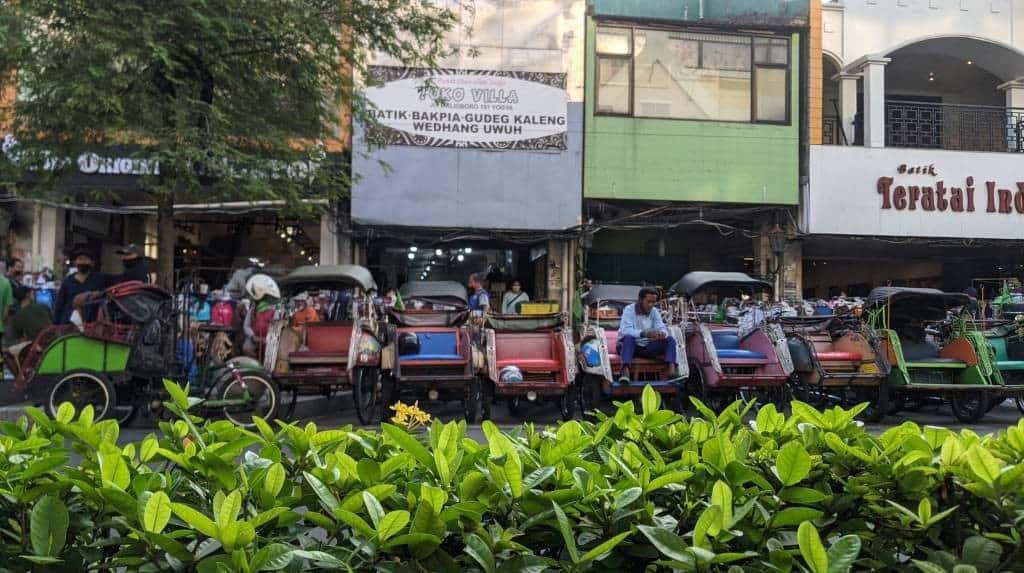
We popped in and out of a few shops but, honestly, I found it too crowded. I don’t know if there was an event going on or if I was getting dehydrated, but it was starting to feel a bit overwhelming. I couldn’t really enjoy it, no matter how much I tried.
So after about an hour we ended up calling our driver to come back and pick us up. I was really disappointed because I was looking forward to picking up a cute batik dress for my granddaughter.
Day 2: Borobudur Temple, Lunch, and Bukit Rhema
Borobudur Temple
On our second day, we visited Borobudur Temple, the largest Buddhist temple in the world.
Once we purchased our tickets, we were placed into a tour group with an English speaking guide. It was about a 30-minute walk along a paved walkway to reach the temple. The guide was sharing the history and significance of the temple as we walked.
As you approach the temple, that’s when you really get a sense for how massive this place is. It’s like the equivalent of a whole city block! Some people compare its size to Angkor Wat in Cambodia.
We were only given one hour to actually climb the temple structure itself. Considering there are nine different levels, I wasn’t sure if it would be enough time. We were moving slow due to the heat, and didn’t want to over exert ourselves. Even with having to climb the steep steps up to each level, that 60 minutes was plenty of time.
Without going into all the details, each of the levels takes you through different phases of the spiritual journey to enlightenment. There are stone reliefs carved into the temple walls on the lower levels and as you climb upwards, you pass hundreds of buddhas lining the temple walls.
Then, as you reach the top, that’s when you get to see the stupas up close. The stupas are those things that look like domes. They are all supposed to have a buddha inside of them but over time some of the buddhas have been destroyed.
Read more: Tips for Visiting Borobudur
Visiting Borobudur Temple was an incredible experience and I’m so glad we didn’t try to combine it with Prambanan Temple the same day.
Borobudur is about an hour’s drive from Yogyakarta
Entrance fees are approximately IDR 375,000 ($27 USD) for adults. Daily visitor numbers are capped, so it’s best to buy tickets in advance.
Lunch at Truntum Gasblock Borobudur
After Borobudur we were ready for lunch and headed over to Truntum Gasblock Borobudur. It’s only about 10 minutes away so it was a relatively quick drive.

Once you get there, you follow a wooden boardwalk that weaves through a rice field until, voila! You’re at this incredible open-air restaurant in the Magelang countryside.
There’s sort of a chic industrial feel with clean lines, polished cement, wooden communal tables, and breezy white drapes hugging the corner posts. The ambiance, combined with how remote it is, just feels so surreal.
We ordered several different Indonesian dishes but they also had some western items on the menu as well. Everything was delicious! I wish I had more pictures to share with you but unfortunately, I don’t. I did get one of my iced coffee drink with a side of sugar syrup though! LOL.
Chicken Church (Bukit Rhema Gereja Ayam)
After lunch, we went to visit the Chicken Church, a very unconventional structure resembling a giant chicken. Yup, a giant chicken! Quite unique to say the least! I mean, look at this thing.

Originally intended as a multi-denominational prayer house (it still is), it has become a quirky little attraction.
From the parking lot, you’ll hop into a 4WD vehicle for the steep, bumpy ride to the top. Tickets are purchased there and include a short guided tour through the prayer rooms – required out of respect for anyone praying.
After the tour, you’re free to explore on your own. Don’t miss the spiral staircase up to the chicken’s head for amazing views out the beak! Only a few people are allowed up at a time, we waited about 30 minutes for our turn.
One heads-up: it gets hot inside. There are fans, but airflow isn’t great, especially in the head. Bring water and maybe a personal fan!
Allocate 1-2 hours for your visit. The entrance fee is less than IDR 30,000 ($2 USD).
How to Get to Yogyakarta

There are two ways people usually get to Yogyakarta.
Fly to Yogyakarta
The quickest way to reach Yogyakarta is by flying into Adisutjipto International Airport (JOG). The airport is about 30 minutes away from the center of town.
From the airport, you can take a Bluebird taxi or Grab to reach your accommodation. The cost for a ride into the city center is approximately IDR 100,000-150,000 ($7-$10 USD).
Take the Train to Yogyakarta
This is how we went. We took the train from Jakarta to Yogyakarta. The train departed from Gambir Station in Jakarta and arrived at Tugu Station in Yogyakarta about seven hours later.
The train from Jakarta to Yogyakarta will cost between IDR 250,000-500,000 ($17-$35 USD) depending on the class of service.
Getting Around Yogyakarta

Private Driver
For ease and convenience, especially if you plan to visit sites outside the city, I highly recommend hiring a private driver. Expect to pay around IDR 500,000-700,000 ($35-$50 USD) per day.
Grab
Using Grab in Indonesia is similar to using Uber in the United States. If you don’t hire a private driver for the day, this is the next best way to get around Yogyakarta.
Becak (Cycle Rickshaw)
For shorter distances within the city, riding a becak is a uniquely fun experiences that you should try at least once. A becak is essentially a motorized rickshaw. You sit in the open carriage in the front with the driver on a motorized bike attached behind you.
We bargained with one to give us about a 30 minute drive around the city. It cost us about IDR 35,000 ($2.00 USD).
Public Transport: Public buses and mini-vans (angkot) are available and will cost less than using Grab or hiring a private driver. But, if you only have two days in Yogyakarta, you probably don’t want to make your plans based on a bus schedule.

Where to Stay
There are so many cute places to stay in Yogyakarta that it was hard to pick one. So, we didn’t. We picked two! We stayed in a different hotel each night.
Greenhost Boutique Hotel
We stayed at Greenhost Boutique Hotel in Yogyakarta, and I seriously loved it. The moment you walk in, you just feel better. It’s like the whole place is quietly exhaling. There are living walls covered in hanging plants, and even the walls themselves are left unpainted so they can “breathe.” It’s peaceful, airy, and feels like you’re both inside and outside at the same time.
The courtyard has a beautiful pool surrounded by more living greenery, and up on the rooftop, they’re actually growing food in their garden. The rooms were super spacious, and breakfast was a whole experience, with different Indonesian dishes.
Room rates start at around IDR 600,000 ($40 USD) per night.
Adhisthana Hotel
We also stayed at Adhisthana Hotel in Yogyakarta, and I loved it just as much as Greenhost, but for totally different reasons. Where Greenhost had living walls, Adhisthana had walls covered in old doors. Seriously, so cool. The vibe was crisp and clean, with white walls and warm wood accents everywhere. I especially loved the double wooden doors to each room. So special and inviting.
Room rates start at around IDR 500,000 ($35 USD) per night.
Additional Things to Do in Yogyakarta
There were so many other things we wanted to see while we were in Yogyakarta but there simply wasn’t enough time. If we had an extra day or two, here’s what I would have worked into our itinerary.
Kraton (Sultan’s Palace)
Kraton is the royal palace of the Sultan of Yogyakarta. You can walk around the palace grounds, learn more about Javanese culture, the royal family, and the history of Yogyakarta. You might even catch a traditional music or dance performance if you arrive during the right time.
Taman Sari (Water Castle)
Not far from the Kraton, is Taman Sari, also known as the Water Castle. You can wander around the pools, gardens, and tunnels of this former royal garden, which was once used by the Sultan and his family.
Batik Workshop
Yogyakarta is famous for its batik, and several batik workshops around the city have hands-on experiences where you can learn the traditional wax-resist dyeing technique and create your own batik piece.
Mount Merapi
Mount Merapi is an active volcano located just north of Yogyakarta. You can do things like take a jeep tour around the lava fields and visit the Merapi Volcano Museum.
Is 2 Days in Yogyakarta Enough?
It depends on what you want to see. I thought two days was enough time to see Prambanan Temple, Borobudur Temple, and a couple other cultural and historical sites.
If you want to get a feel for Yogyakarta beyond the two temples though, I recommend spending three days in Yogyakarta.
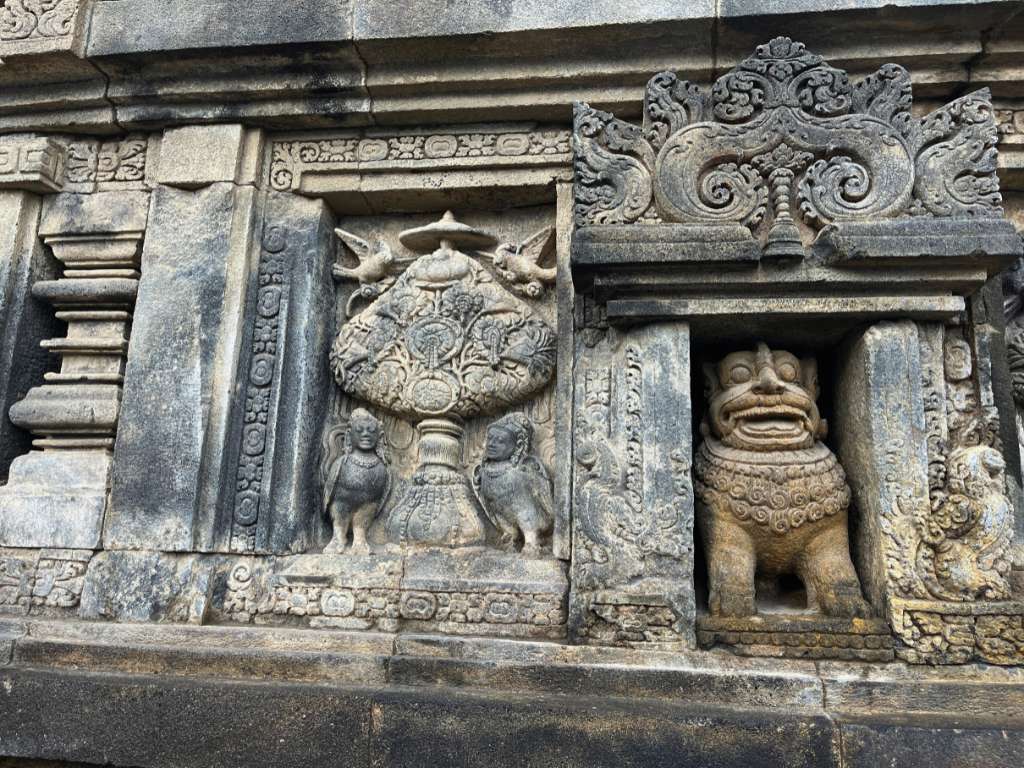
Travel Tips for Yogyakarta
Stay Hydrated: Yogyakarta can get quite hot and humid, especially during the day. Drink plenty of water and then drink more!
Dress Modestly: When visiting temples, dress modestly. Wear clothing that covers your shoulders and knees. Sarongs are often provided at the entrance if needed.
Bring Cash: While many places accept cards, small vendors and some attractions might only accept cash. It’s a good idea to carry some Indonesian Rupiah (IDR) with you.
Negotiate Prices: In markets and with local transport services like the becak rickshaw things, don’t be afraid to negotiate for a better price.
Plan for Traffic: Yogyakarta can experience heavy traffic, especially during peak hours. Allow A LOT of extra travel time when moving between sites.

Final Thoughts
Even though we only had about two days in Yogyakarta, we were able to see everything we came for and then some. Visiting Borobudur and Prambanan was unforgettable, and let’s not forget that quirky Chicken Church!
Yogyakarta has such a great energy. There’s a mix of history, culture, and everyday life and it’s definitely worth a visit if you’re in Java. Two days was just enough for the highlights, but if you can add an extra day, I’d absolutely recommend it.
It was the perfect little getaway from Jakarta, and a part of Indonesia I’m so glad we got to experience.
Resources to Book Your Trip
Flights
I like using Skyscanner to find flight deals. It searches hundreds of airlines and booking sites so you can compare prices, dates, and even airports in one place.
Accommodations
Booking.com is my go-to for hotels, guesthouses, and apartments. I like that you can filter for free cancellation and check reviews before you book.
Activities
For tours and experiences, I recommend GetYourGuide and Viator. Both have everything from walking tours to day trips, plus instant booking and mobile tickets.
eSIM
I’ve used Airalo and Saily for internet access when I travel. You can install the eSIM on your phone before you even leave home and there’s no need to swap physical SIM cards.
Airport Pickups
If you want a stress-free ride from the airport, check out Welcome Pickups. Your driver will meet you inside the terminal, help with your bags, and take you straight to your hotel.
Car Rental
Discover Cars makes it easy to compare rental companies so you get the best rate. You can see all the options and book in advance for peace of mind.


